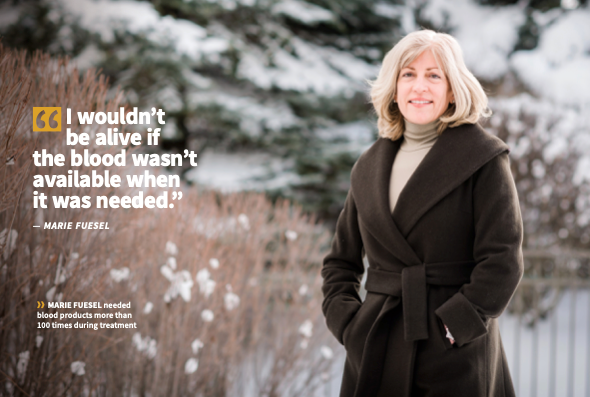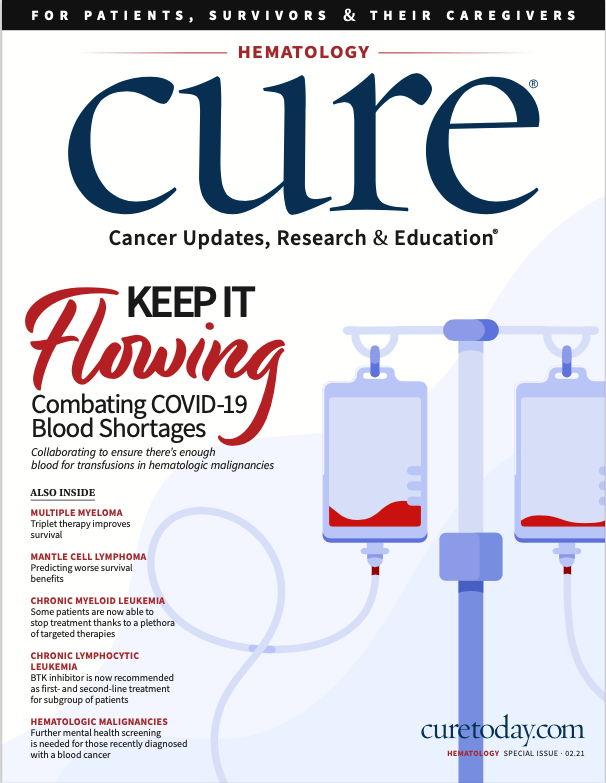Publication
Article
CURE
Keep it Flowing: Combating COVID-19 Blood Shortages in Cancer Treatment
Author(s):
Blood shortages during the COVID-19 pandemic have forced cancer centers to get creative to ensure patients with hematologic malignancies are able to get transfusions in a timely manner.
When Marie Fuesel was treated for leukemia eight years ago, she needed donated blood products more than 100 times.
“They’d give me my chemotherapy, I’d stay in the hospital for a week, then I’d go home, get really sick and have to come back in for blood and platelets,” says Fuesel, 53, a retired insurance agent who lives in suburban Chicago. “I spent over 100 days in the hospital over eight months. The disease and treatments (affect the bone marrow and production of red and white blood cells and platelets), so many transfusions were required to achieve remission.”

After eight months of chemotherapy, followed by a year on the targeted drug Sprycel (dasatinib) as part of a clinical trial, Fuesel went into remission. She no longer needs transfusions, but she still appreciates the need for blood donors. “I wouldn’t be alive if the blood wasn’t available when it was needed,” she says.
Back then, blood shortages weren’t common, but they are now. The stay-at-home orders at the beginning of the COVID-19 pandemic forced the cancellation of numerous blood drives, and safety concerns arising from its spread have prompted some frequent donors to stay away from donation centers.
That’s been a source of worry for oncologists. Patients with cancer use nearly one-quarter of the nation’s blood supply, according to the American Red Cross, and donated blood is a vital resource in the treatment of hematologic cancers. Patients who receive stem cell transplants often need transfusions of oxygen-carrying red blood cells, infection-fighting white blood cells and platelets to control bleeding. Blood transfusions are common in the supportive care of patients undergoing chemotherapy that suppresses production of all the blood cells that results in anemia, because they relieve symptoms that ensue, such as fatigue and shortness of breath.
Between March and June 2020, 37,000 blood drives were canceled, according to the American Red Cross. The impact of the blood shortage varied across the nation but has hit some cities particularly hard. The New York Blood Center, for example, which supplies New York City
hospitals, reported in December 2020 that it had just three days of supply on hand, down from the five- to seven-day supply it normally has.
Ongoing shortages are forcing cancer centers to change some of their procedures for using donated blood. “We all recognize that we are in the midst of a public health crisis and that we all have to do our part,” says Dr. Mikkael Sekeres, chief of hematology at the University of Miami Miller School of Medicine and a physician liaison in hematology at Sylvester Comprehensive Cancer Center.
Tweaking Transfusion Thresholds
In response to COVID-related blood shortages, several cancer centers adjusted their policies for transfusing blood. Moffitt Cancer Center in Tampa, Florida, for example, developed a blood shortage action plan, according to Dr. Kaaron Benson, director of the blood bank at Moffitt. “It basically meant dropping some of the thresholds we would normally use for transfusion,” Benson says.
Moffitt has not needed to implement the plan yet, but if it does, Benson says, the change would most likely have the biggest effect on patients with leukemia and lymphoma who are given platelets as a preventive strategy. “Provided they’re not bleeding or engaging in activities that increase the risk of bleeding, studies have shown you can allow the platelet threshold to drop from our standard of 10,000 per microliter to 5,000,” she says.
The technique was first suggested in a 1991 journal article and has since been widely accepted as an appropriate change to make during blood shortages, Benson says.
In recent years, many oncologists have set lower thresholds for red blood cell transfusions — another change that has eased the strain on blood supply. They used to routinely order transfusions for patients with hemoglobin levels below 10 grams per deciliter. That number dropped to between 7 and 8 grams per deciliter after a series of studies showed that infusing red blood cells at the higher threshold did not improve treatment outcomes.
During the pandemic, Moffitt and other cancer centers are also delaying some stem cell transplants and elective surgeries, so that blood used during those procedures can be kept on hand for patients who urgently need it, such as trauma patients or those needing emergent surgery. But those decisions are made on a case-by-case basis, so patients should maintain a frequent dialogue with their oncologists to determine the best plan for managing their symptoms during the pandemic.
Patients with multiple myeloma, for example, can benefit from stem cell transplants, but it’s usually not urgent, says Dr. Stephanie Lee, a hematologist and professor at the Fred Hutchinson Cancer Research Center in Seattle. “We have very good treatments for multiple myeloma, so we can continue to give patients chemotherapy for weeks or months,” Lee says.
However, she explains, patients with leukemia who need stem cell transplants may be advised to undergo the procedure as quickly as possible, even during the pandemic, because delaying it could cause the cancer to grow and become resistant to treatment.
And some patients with cancer who are simultaneously fighting other diseases should receive all the blood and platelet transfusions they need to manage their cancer, as well as to address any risks posed by chronic conditions. “If you have heart disease, and your hemoglobin drops even further, you’re more likely to get angina or suffer a heart attack,” Sekeres says. “So, for those people with serious comorbidities, we are more aggressive in transfusing blood products.”
Growing the Donor Pool
Stephenie Perry, who works as the business operations coordinator for the American Red Cross of Northwest Georgia, knows firsthand the value of donated blood. Perry is a survivor of Hodgkin lymphoma who needed several transfusions during her treatment, which consisted of a round of chemotherapy and two stem cell transplants.
Perry, 31, has been in remission since February 2018, but sometimes her red blood cell count still runs low and she needs another blood transfusion. “I feel sluggish, and when I stand up, I get really dizzy,” says Perry, who lives in Rome, Georgia. “When I get a transfusion, it’s like someone has just given me a shot of energy.”
How can patients adapt when blood shortages mandate less frequent transfusions? Lifestyle changes can make a big difference, Sekeres says. “If a patient is becoming progressively anemic, and it’s someone who usually goes for a 2-mile walk every day, maybe they’ll reduce it to 1 mile or cut (exercise) altogether,” he says.
Some patients may be eligible for iron infusions, which can relieve symptoms of fatigue and lengthen the period between infusions, says Abbey Fueger, clinical trial nurse navigator for the Leukemia & Lymphoma Society.
In addition, there are other small changes that can lessen the risk of anemia and improve symptoms. “Some physicians are trying to limit blood draws for patients and recommending nutritional supplements that might help them feel better and lengthen the time between infusions,” she says.
Meanwhile, an effort is underway to expand the pool of potential blood donors. In April, the Food and Drug Administration (FDA) addressed blood shortages brought on by COVID-19 by easing up on some of its restrictions on who can donate. For example, people who are at risk of contracting HIV, and those who have a recent tattoo or piercing or possible exposure to an infected individual no longer have to wait one year to give blood. The new waiting period is three months.
The FDA also dropped the waiting period for donors who have traveled to malaria-endemic countries from one year to three months. And it no longer recommends that blood centers turn away donors who lived in certain European countries during the era when Creutzfeldt-Jakob disease, a rare and fatal degenerative brain disorder, was thought to be spreading.
The hospital community is rallying around the cause, holding blood drives of their own and encouraging family members of patients to donate blood.

During the first few months of the pandemic, Fuesel helped put together five small blood drives in her town of Orland Park, Illinois. They were so successful the American Red Cross and a local news broadcaster asked her to help run the seventh annual Great Chicago Blood Drive. So, she did, and on Jan. 13, that event collected 330 units of blood at the Orland Park location and more than 2,000 units at other drives around the city.
For donors who might be nervous about giving blood during a pandemic, Fuesel has a message: It’s safe and important. “All the beds are spaced apart, and there are different stations when you walk in for getting your temperature checked and using hand sanitizer,” Fuesel says. “I know these are hard times, but it doesn’t cost anything to give your blood. It’s a way to help.”





